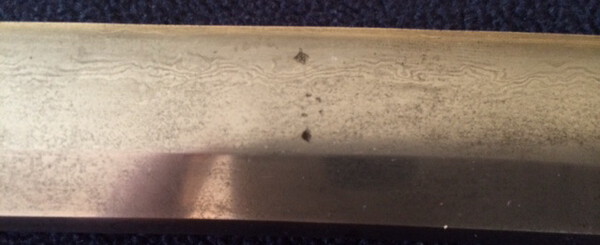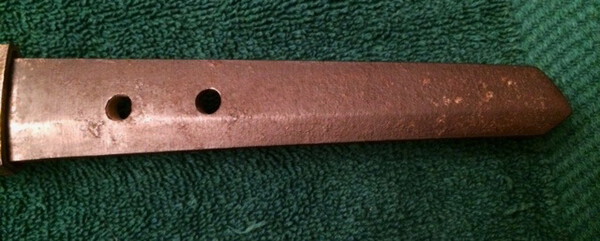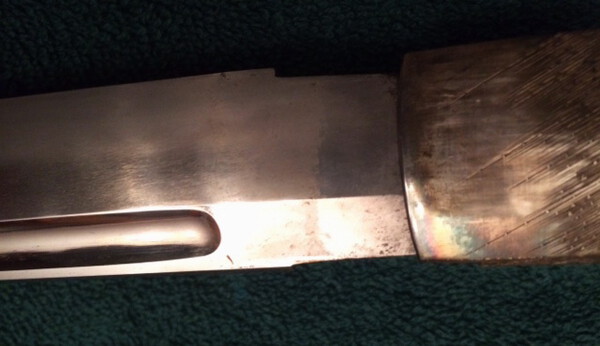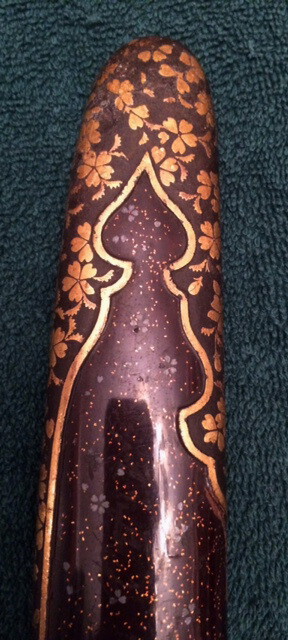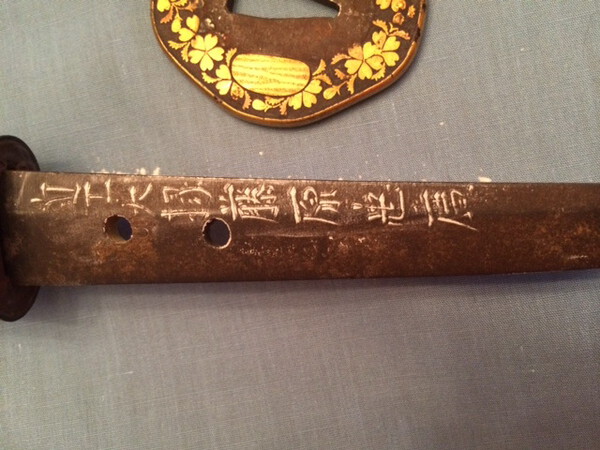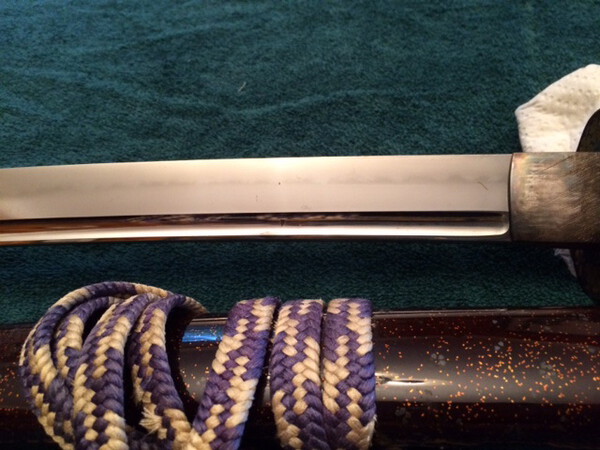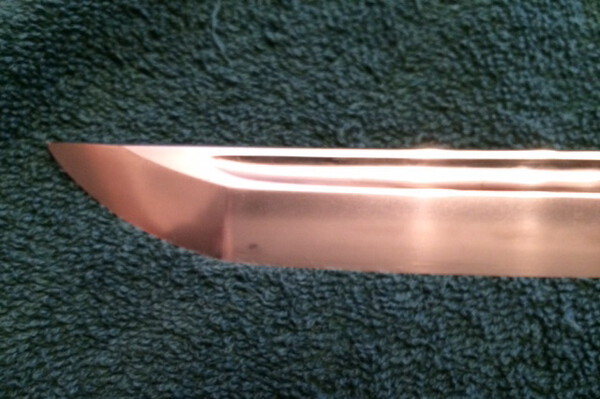
charles heesh
Members-
Posts
18 -
Joined
-
Last visited
Recent Profile Visitors
The recent visitors block is disabled and is not being shown to other users.
charles heesh's Achievements
-
Thank you Very much Morita san. This is what I was looking/ hoping for when I contacted this group. This Mei has been a challange and I have learned from the experience. The young man who owns this sword will be very pleased. As am I. Thank to all who contributed, this is a great group of folks just trying to help us less educated. Brian, isn't this what its all about? Thank You again Morita san, Sincerely, Charlie Now back to just watching and more learning.
-
-
-
Good mornin to all and thank you all for your insights / opinions Vajo (Chris) thank for your efforts, I O Hiragana maybe not correct, but at this point more than I had. However Chris is is not an old blade, workmanship is not that good, tang lacks patina, Mekugi anna is drilled. I believe this is a WWII period sword and am further that it was made in a arsenal of mill steel.There are no arsenal stamps on it, but as we know stamps were not used initially. maybe the sword was made before that time. one of the puzzles with this sword is why the mei first Kanji is so high on the tang that it is covered by the Habaki. As for Rokujuro's, (Jean's), I agree with most of your comments but do believe it is WWII era sword.I will post some additional photo's of the tang, Nakago in awhile. Please understand - the sword is not for sale I am not charging the young man for whatever I can learn. Just trying to help him find out what he has. Thank you all again, has been an interesting puzzle so far which is why I love following this group discussion. Hopefully we all learn. Take care, Charlie
-
Ok Thanks for the opinion Vajo. I am very curious about this sword. Alot of unusual aspects. Look @ hamon in the new pictures. see the wave or irregular pattern? But it is only in the Hamon. These sort of wavey lines for lack of a better term, makes one think it looks like Chinese but its not in my opinion. Can't see much else due to surface discoloration. What do others think? C
-
Hello all, Thank you for the interesting discussion. I agree it is not a Chinese or other country look alike. Pictures will, I hope bear this out. This sword was given by a family member to the young man who owns it. It has been in the family since end of the war. Sword appears to be WWII or a bit earlier due to two Nakago Ana the lower one fits the present Tsuka. Sword is unsharpened first few inches after brass Habacki, standard cutting edge 26 inches. Hamon is visable in a few places, is Sambon sugi, maybe able to see this in one of the picts. file marks are straight across on Nakago not the usual hawk feather style we see on many Guntos Appears to be hand forged, but the polish it is in poor condition due to neglect and I am unable to see and activity in the jihada. I think this cursive style of writting is called Go sho? I have seen this style of Kanji but not often Hope additional pictures will help. Thank you for your reply and I will pass it on to the family member
-
-
Back in early December I recieved a photo of a WWII or earlier sword with kanji in a style I am unable to translate and have no refferance books for. The photo was of poor quality. I now have this sword in hand and have taken some new and hopefully better photos of the kanji. Any assistance would be much appreciated Happy Holidays to all, Charlie
-
Hello Steve, Thank you for your reply. When the sword comes to me later this month will be able to take much better pictures and will ask again for assistance. Til then, Happy Holidays, Charlie
-
Hello All, I am in need of assistance with translating the kanji on this Katana. The photo was taken with a smart phone and sent to me. I had advised the young man who owns this sword to highlight the kanji with Talcum powder but he did not do a great job. I do not have this sword to make a better photo. I belive this form of Kanji is called Go Sho(?) and I do not have the books necessary to translate. But then I am not very well versed in this style anyways. The fellow lives in Maryland and has agreed to bring it to me around Christmas holidays. Any assistance this forum could provide would be greatly appreciated. The young man recieved the sword from a family member and was taken during WWII by his great uncle. He does intend to have it restored at sometime in the future. Thank you all for your efforts, Charlie
-
Thanks to Paul for the good advise. The sword is yet to be mine but the possibily exists, we will see what happens as with the move i do not have alot of spare $ put towards it. Has none the less been an interesting study and a heart felt Thank you to all who have commented. Great Forum Brian! Additional photo's just to look at. Hope it's worth a look. Charlie
-
Hi to all, Thank you to all who have ventured an opinion on this sword. In one of my prior posts I had stated I recently retired. Add to that I am selling my house in Binghamton and moving to smaller quarters so much of my books on J swords were stored away. I have found my copies of Fred Fimio's Token Bijutsu amd The Connisseur's book by Nagayama. Plus I have looked @ this site and others in my research. I am very grateful to the members for their opinion on this sword. Rest assured I will not quote anyome as I take all as strictly an opinion not a validation. My research leads me to conclude the signature is gemei. Omi Diajo did sign some swords Katana Mei and the comment regarding the size of the kanji, I think my pictures with with powder to enhance the mei may have made it look larger. I will post additional pictures of the full tang, both sides, plus additional photos of the blade itself, which to my eyes is constructed exactly as Omi Daijo would have when reading the description in my books. What does appear to be a problrm is some of the kanji, specifically the top stroke of Hiro. This stroke in every signature I have seen is vertical not horizontal as it is on this sword. No matter how old this smith lived I don't think that stroke would have changed. The sword is beautiful even in its current state of polish. I have found several refferances which state there were some Very good Gemei blades made. I think this is what this sword is. Again Thank you to all for your comments this has been a good learning experience for me. Charlie
-
Hello to all and thank you for your advice and opinion. Mark, the Nagasa is 25 3/4 inches from the point to the habacki, notch, but note it has 2 Mekugi anna so the machi has been moved up at one point in the past. So not a wak but a Katana. I have a number of books on Japanese swords but none specifically related to Hizen, thus the question asked, if there is a member who is more familiar with Hizen swords. I do agree that the Koshire is above average, is it possible to restore the Baleen? I appears to me that it is all there just cut to remove the Menuki. Or can Baleen be replaced? I am aware that Whales are a endangered species and maybe it is not possible to get it. Also all the other mounts match so would be best if a new set of matching Menuki be made, this is sounding expensive. I just retired!! The sword is not mine. The picker knows enough that he thinks its a good sword, mostly from the Koshire and the sword is not chipped, rusted or bent. He does not know how to remove the handle and in the past I have warned him against trying to removing them as they sometimes can be damaged in the process. That said, I do have the sword in my home for study. I have had it a week now and he has not asked for it back. I may try to purchase it rather than have him consign it to a local auction. I can take more pictures of the Nakago full length and the other side which has no kanji, but straight across file marks. As noted to Mr. Helm although it is in fairly good condition it is in need of a polish to really see the details. I am willing to try if that would help in determining if it "maybe" genuine. I understand the members not wanting to make a determination but could someone comment on the kanji. Would you agree that the stroke at the top of Hiro which is horizontal rather than vertical as in some other signatures I have seen on line. That stroke has me wondering. Again thank you to all for your comments. Charlie in up state NY, Binghamton to be more precise.
-
Hello Tom, Thank u for the comment. Will wait for other replies before attempting to take close up picts of the sword. I am not that good with a camera and taking picts of the blade is challanging to say the least. Hamon and hada are not well defined, needs a polish. That said, the over all sword is in good condition with only a few spots of rust, no chips but the tip has been blunted. From comparing the kanji of known works by this smith on line, this signature poses questions in my mind. For example the top stroke in Hiro is vertical in the genuine but on this blade it is more horizontal. Am I being too critical? sadly I do not have access to Fujishiro's book. Thank you again Charlie
-
A local picker recently found a Katana, signed Omi Daijo Tadahiro. I was able to determine the signature but am unable to determine if it is a true or false signature. I am requesting the assistance from the group. There are several pictures attached, including the Koshire which is very nice except where the idiot cut the Baleen to remove the Menuki which I can only assume matched the rest of the mounts. Thank you all for any information.






